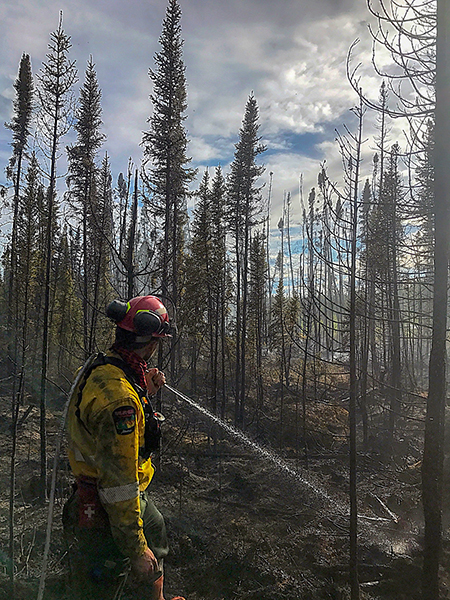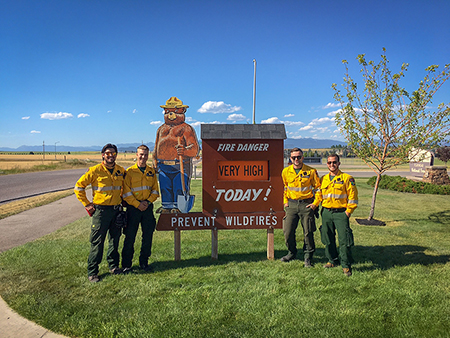Forestry Technology grads share what motivates them to battle blazes
The first batch of emails trickle into Kevin Martens’ (Forestry Technology ’18) inbox around mid-December. Wildfire season doesn’t start for another four months, on March 1, but the notes from Alberta Wildfire crew supervisors are enough to get the blood pumping in anticipation of a return to one of the hottest jobs around.
For firefighters like Martens, a wildfire crew chief in the High Level area, winter is a long and sometimes tedious break from the work they love: protecting Alberta’s forests and communities.
“You get very antsy,” says Martens. “Once you get that email, you start looking at the upcoming season, who’s coming back that you know. There’s definitely a buzz.”
Martens and Luke Mahura (Forestry Technology ’18) are recent graduates of NAIT’s Forest Technology program – a path they both pursued to help advance their careers as wildland firefighters. The hours can be long – especially when a fire is active – and the work is physically demanding, not to mention punishingly hot. They put up with the sweat and toil not only out of a sense of community responsibility, but because they have a healthy thirst for thrill and adventure.
Caring for community
 For both students, that community mindedness factored into their initial forays into the world of wildland firefighting. This will be Martens’ sixth season fighting wildfires, a path he chose initially out of necessity living in La Crete, a small hamlet in a sea of northern Alberta boreal forest.
For both students, that community mindedness factored into their initial forays into the world of wildland firefighting. This will be Martens’ sixth season fighting wildfires, a path he chose initially out of necessity living in La Crete, a small hamlet in a sea of northern Alberta boreal forest.
When a wildfire burned within three kilometres of his parents’ home in 2012, the community pitched in and so did Martens. He drove a tractor outfitted with a water tank, pump and hose – both loaned by his dad’s company – and worked alongside firefighters from the area and British Columbia as they identified and extinguished hot spots.
“You put yourself in that situation and imagine your house got burned down, so you want to do the best job you can to prevent that.”
“I’d already planned to apply [for the provincial wildfire] program that year, so it was interesting seeing what I was getting into. That made me want to go even more.”
After two seasons as a wildfire detection aid near Slave Lake, Mahura set his sights on joining the province’s helitack program, which he did this past spring and, eventually, as an air attack officer directing air tankers and helicopters.
Mahura grew up in St. Albert but his family’s roots are in Slave Lake. When a massive wildfire burned 4,700 hectares of forest in 2011, it destroyed 400 structures, including the home of his girlfriend at the time and other friends and family. Seeing that kind of devastation fuels the desire to help, he says.
“You see a lot of people that are affected and you just want to help out so much. You put yourself in that situation and imagine your house got burned down, so you want to do the best job you can to prevent that. That’s a cool part of the fire business.”
Heat and adrenaline
 Fighting fires in some of Alberta’s wildest and most remote backcountry isn’t for everyone. Just getting to a hot spot can mean hauling gear and wearing portable water tank units on the back for hundreds of metres through challenging terrain such as brush or muskeg. And then there’s the toil of working a chainsaw to cut away at trees that could fuel the flames or digging trenches in the earth to steer a fire’s direction.
Fighting fires in some of Alberta’s wildest and most remote backcountry isn’t for everyone. Just getting to a hot spot can mean hauling gear and wearing portable water tank units on the back for hundreds of metres through challenging terrain such as brush or muskeg. And then there’s the toil of working a chainsaw to cut away at trees that could fuel the flames or digging trenches in the earth to steer a fire’s direction.
“You take breaks throughout the day but you pretty much work until the fire is extinguished or the day’s done,” says Martens. “The whole time we’re working it’s usually [in] really hot conditions so you’re exerting your body and sweating a lot.”
As much as they want to fight wildfires to help friends and neighbours, the work is also heart-pumping fun.
“The adrenaline rush kicks in every time you get a phone call,” says Martens. “You get to the fire – I’m a crew leader so I have three guys working under me – it’s like puzzle solving as you go. Every fire is different; you strategize a lot, work with different aircraft, different crews. It’s challenging and a bit of an adrenaline rush.”
Mahura, who played hockey his entire life including one year with the Ooks, likens firefighting to competitive sports. The adrenaline rush you get when making a play or dishing out a hit is comparable to working the front lines of a wildfire. “It’s hard to explain until you actually get out there and do it.”
International community
Western Canada has seen its share of major wildfires in recent years, from Fort McMurray in 2016 to several blazes that tore through B.C.’s interior in 2017. It’s not uncommon for firefighters stationed at a major fire to work alongside peers from other provinces or countries as jurisdictions come to each other’s aid.
When there was little fire activity in the Slave Lake district last summer, Mahura ended up fighting the Gladiator Mountain fire in Montana, where nearly two dozen wildfires consumed more than 500,000 hectares of forest. Gladiator Mountain is the largest fire he’s fought to date.
During a bad fire season in 2015 in High Level, Martens says local firefighters were joined by colleagues from B.C., Nova Scotia, Ontario and crews as far away as South Africa and New Zealand. It makes for an interesting mix of cultures and learning about each other’s tactics.
“It’s challenging, it’s physically demanding and the big one for me is the people that you meet,” he says. “You meet a big range of people, whether it’s pilots, crew members, office [staff]. It’s a huge networking opportunity; it’s awesome.”
Mutual aid agreements are essential to meeting the resource and staffing demands of fighting large, extreme wildfires. With climate change, those extreme fires are happening more often due to hotter, drier conditions. As a result, Alberta has moved up the start of wildfire season by a full month, to March 1.
The early start to fire season means Martens and Mahura will have to wait on the sidelines until they complete their studies. Mahura has April 27 – the last day of classes – circled in his calendar. He plans to be in the field within three days.
“Everyone else will have been working for a month and I’ll be sitting in class writing exams, which kind of sucks. You just want to get out there.”
Help prevent wildfires
A warm spring and dry conditions increase the risk of wildfires, says Chris Klitbo, a wildfire instructor with NAIT’s Forest Technology program. Most wildfires are caused by lighting or people. Here’s what you can do to help prevent fires from starting.
1. Put out that fire
If you’re camping or burning debris around an acreage or farm, be mindful of the fire and the time of year. “When it’s spring, you have dead grass from last year,” Klitbo says, “so you should always be concerned about burning in the springtime.”
And always follow provincial and local fire bans.
2. Be careful with your ATV
When ATVs get stuck in the mud, organic matter can build up around the muffler and increases the risk of a spark and fire. Don’t ignore provincial off-road vehicle bans.
3. Use an ashtray
It seems obvious that flicking a cigarette butt onto the ground is a recipe for wildfires, especially during a dry spring or summer. But it’s still a common cause of wildfires, including a blaze last year near Airdrie.